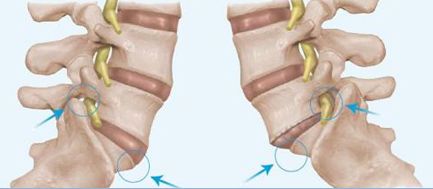The vertebrae analyses – symptoms, treatment, classification by degree
Antelias (anterolisthesis) vertebra – pathological condition, accompanied by the offset of an overlying vertebra anteriorly with respect to the underlying. The opposite condition – retraites, accompanied by its displacement posteriorly.
The Pathology leads to deformation of the spinal column and nerves. The result of the condition is pain arising due to infringement of the nerve roots in the spine or in the thickness of the spastic muscle.

More severe complication is stenosis (narrowing of the spinal canal). Thus there is foraminal stenosis – compression of the nerve roots coming out of the holes between the vertebrae.
Characteristic symptoms

Analyses can be identified by the following symptoms:
- Pain in your lower back;
- Increased pain when stretching the lumbar spine;
- Tension hamstring (neurological symptom);
- Numbness and tingling in the lower extremities
- Strong compression of the nerve trunks;
- Involuntary defecation and urination.
some people analistas causes unique symptoms: additional bone proliferation lower back pain, localized pain syndrome in the gluteal area.
Degenerative analystes has the following degrees of severity:
- Lightweight
- Medium;
- Heavy.
mild Infringement of the nerves of the spinal cord compression does not occur. Pain a person can take without seeking medical help. The symptoms of the disease disappear after taking anti-inflammatory drugs, so the patient does not need to seek medical advice.
However, at the initial stage of the disease is necessary to apply a bandage, which will prevent the progression of the disease. Due to the deformation of the spine gradually increases the pinching of the nerve root.
Degenerative analistas moderate Is accompanied by contractive pains in the lower back. At this stage, when magnetic resonance imaging of the spine can reveal the "melting" of the vertebra, which appears on the background strain of the vertebral column.
Under the melting should be understood gradual decrease in height of the intervertebral segment. Over time, the intervertebral discs are erased, and pinched nerve is compressed even more. At this point, apart from a strong pain syndrome appears the limited mobility of the vertebral column.
The Danger of analistas average degree of the disease is that the underlying vertebra gradually shifts backwards and causes the spinal cord compression. The treatment of this pathology is surgical methods.
for severe disease Occurs radicular syndrome, which is characterized by severe compression of the nerve roots. The person feels numbness of the skin and paresthesia (disturbance sensitivity). At the same time there is a weakness of the muscles, which without adequate treatment leads to paresis and paralysis of limbs.
Complications

Complications arise analysese the following:
- dysesthesia of the lower limbs
- Frequent urination and defecation;
- Paresis and paralysis of muscle tissue;
- Chronic back pain
- Difficulty of digestion;
- spine.
To calculate how much time is needed for emergence of complications in the anterior displacement of one vertebra, it is necessary to perform radiography of the lumbar spine in frontal and lateral projections.
At the time of disability and the emergence of the effects of the disease impact risk factors:
- Hyperextension of the lower back;
- backbone Deformation;
- Chronic injury to muscle tissue;
- Traumatic damage to the vertebrae.
It Should be understood that degenerative low back pain without proper treatment over time can lead to displacement of vertebras. To prevent pathology need to wear a bandage for 1 and 2 degree of narrowing of the intervertebral disc.
When grade 3 and 4 disease should be surgical treatment. As a result of the intervention is the correction of the location of the vertebral column.
Thus, it is possible to prevent the curvature of the axis of the spine with formation of hyperlordosis and reinforced Koposov. They over time lead to instability of the vertebral segments and the impairment of the nerve roots.
Classification and treatment of

Degenerative analystes has the following degrees:
- 1 degree – offset up to 25 percent;
- grade 2 – 26-50%;
- stage 3 – 51-75%;
- degree 4 – 76-100%;
- stage 5 – the vertebrae are separated completely from each other.
At 2-5 the extent of the diseasethere are such symptoms as numbness, leg weakness and paresthesia of the skin. When there is narrowing of the spinal canal appears complete immobilization of the lower extremities. The person becomes fully disabled.
Conservative treatment of displacement of the vertebra anteriorly is carried out as follows:
- anti Inflammatory medications
- Pain relievers
- Novocaine blockade.
Anti-Inflammatory agent used in mild disease. They relieve inflammatory reactions and pain caused edema and congestive changes of the vertebral column.
Painkillers help with inflammatory changes in the nerve roots. If the pain syndrome is due to compression of a nerve in the intervertebral slit, eliminate only novocaine blockade or surgical operation.
What are the common treatments for pain in the lower back:
- bed rest
- anti-Inflammatory compresses
- Electrophoresis with diprospana;
- Support bandage
- physiotherapy
- Rehabilitation procedure.
Rehabilitation after an illness requires recovery within 4-6 months. It allows you to improve flexibility, mobility of the spine.
Drug treatment should be aimed at eliminating the spasmodic contractions of the muscles of the back. Pain often occur due to spasms of the muscles. To fix this, you need to wear a bandage and apply muscle relaxants.
If conservative methods to treat the disease can not, have to do surgery to restore the axis of the vertebral column.
In conclusion, I should add that degenerative analistas impossible to completely prevent. However, at observance of recommendations of the doctor the prognosis of the disease positive.













